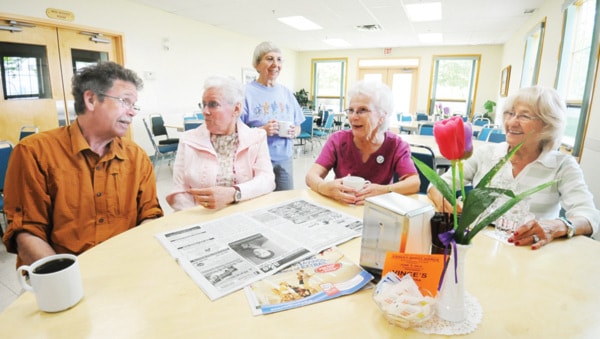Penticton’s population is getting greyer even as the proportion of seniors holds steady, according to fresh census data.
Census 2011 found 26 per cent of the city’s population belonged to the 65-plus set, almost double the B.C. average, but unchanged from the last count in 2006.
Over that same span, Penticton’s total population rose by 968 people to 32,877, and its median age jumped from 47 to 49.
None of that comes as a surprise to 80-year-old Tyra Wells, who has lived here for the better part of six decades. She said family, amenities and good weather keep her, and other local seniors, firmly rooted.
“Why do you get up and move any other place?” she said Wednesday, while having coffee at the Seniors’ Drop-In Centre, one of three places she volunteers.
“It’s not the same place as it was in 1970 anyway. It’s a new place, new stores coming up and all of that stuff.”
What does concern her, however, is the dearth of young folks. Just 16 per cent of the city’s 2011 population was composed of people between the ages of 15 and 29, the same as in 2006.
“You want the young people here running the businesses,” Wells said. “I’m someone who would like to buy all my clothes and my food in town here.”
She said while Penticton is a good place to grow old, it could use more assisted-care facilities for people with minimal needs: “Assisted to a point; a lot of them can more or less take care of themselves.”
Interior Health agrees, and that’s why it’s opening 66 new beds this year at Haven Hill Retirement Centre, said Donna Lommer, the health authority’s chief financial officer.
Her agency relies heavily on census data to predict and meet future demand. The focus right now is on the coming wave of baby boomers, who will soon begin enjoying their seniors’ discounts.
Boomers, generally considered to be between the ages of 45 and 64, made up 30 per cent of Penticton’s population in 2011.
As a result, “The whole shift over the last five to seven years has been to de-emphasize the use of acute-care facilities and try to provide care closer to home, and really concentrate on that shift to move resources into the community,” Lommer said.
“It’s going to be a challenge. We know that. Especially in today’s economic times as our funding is on the downhill slide... so we do need to get innovative in how we deliver services to manage the demand coming at us.”
Penticton Mayor Dan Ashton, himself a 57-year-old boomer, said the city needs more of his ilk, because it’s middle-aged people who buy homes, spend disposable income and fill schools with kids.
”That’s a group that we want to attract,” Ashton said.
The lure, he continued, is “jobs, jobs, jobs,” which council has tried to spur with “a stable tax regime” and business enterprise zones.
Outside Penticton city limits, the population is even more heavily skewed towards seniors.
Within the Regional District of Okanagan-Similkameen, 28 per cent of its 80,742 residents were 65-plus in 2011, and the median age was 52. Meanwhile, seniors accounted for 38 per cent of the 1,667 residents on the Penticton Indian Reserve, where the median age hit 56.
Percentage of population by age group
Penticton (pop. 32,877)
15-29: 16%
45-64: 30%
65-plus 26%
Kelowna (117,312)
15-29: 20%
45-64: 28%
65-plus: 19%
Oliver (4,824)
15-29: 13%
45-64: 30%
65-plus: 34%
Osoyoos (4,845)
15-29: 10%
45-64: 32%
65-plus: 39%
Summerland (11,280)
15-29: 13%
45-64: 33%
65-plus: 28%
Vernon (38,150)
15-29: 17%
45-64: 29%
65-plus: 23%
Source: Statistics Canada Census 2011
